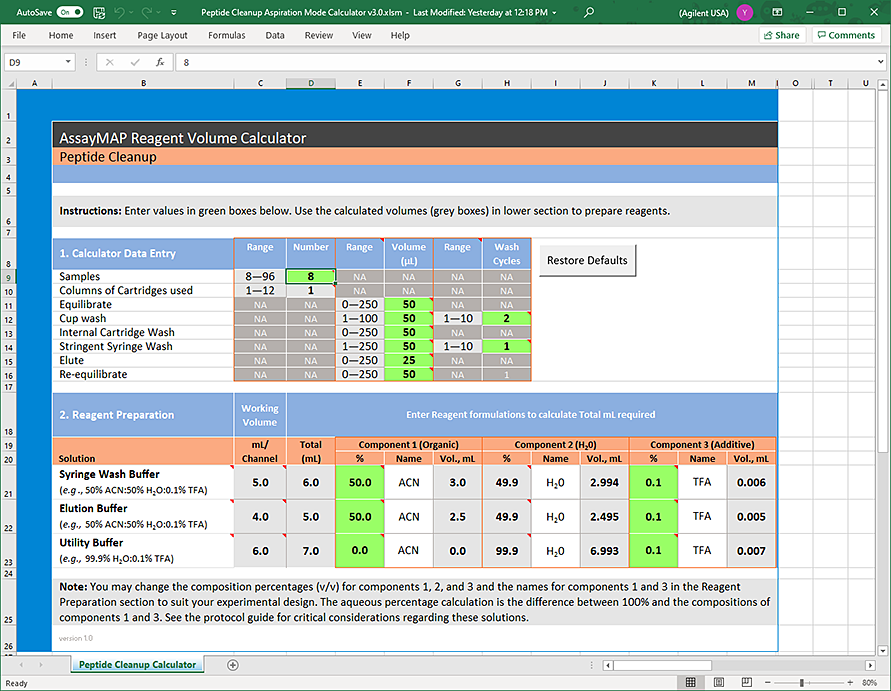Preparing the solutions

The following solutions are required for the Peptide Cleanup: Aspiration Mode protocol:
• Priming & Syringe Wash Buffer
• Equilibration & Cartridge Wash Buffer
• Elution Buffer
Note: You can find the Labware Reference Guide in the Literature Library page of the Protein Sample Prep Workbench.
Using the Reagent Volume Calculator for Peptide Cleanup: Aspiration Mode
The Reagent Volume Calculator is a Microsoft Excel file that contains a Calculator worksheet. You enter the number of columns to process, whether to perform the Collect Flow Through options, the volume for each step in the protocol, the number of wash cycles to conduct, and the labware selection for each deck location. The calculator determines the volumes required based on your input, taking into consideration pipetting overage and evaporation concerns.
Note: The pipetting overage suggested is generally conservative. The minimal overage may be greater or less depending on the volatility of the solution, the length of the run, and when the step occurs during the run. The overage volume can be optimized to minimize loss of precious reagents.
To use the Reagent Volume Calculator:
1 Open the App Library.
2 Locate the application, and then click the corresponding Calculator button. Microsoft Excel starts and displays the calculator.
3 Ensure that you enable content in Microsoft Excel.
4 Click Restore Defaults.
5 Modify the values in the green boxes as required to match your specific method. As you change the values in the green boxes, the calculated values change.
Note: The green box should remain green after you enter a value. If you enter a value that is outside the normal working range, the box becomes yellow. If you enter a value that is outside of the acceptable range, the box becomes red.
To display the corresponding tooltip for a setting, mouse over a box that has a red triangle in the upper right corner.
The following figure shows the worksheet of the Reagent Volume Calculator.
Figure Reagent Volume Calculator for Peptide Cleanup: Aspiration Mode
 |
Preparing the buffers
The following table describes the reagents and deck locations. The AssayMAP protocols are blind to the composition of the solutions, so you can easily adapt your optimized chemistry. Agilent recommends the following buffers as a starting point for optimizing the AssayMAP Peptide Cleanup: Aspiration Mode chemistry.
Table Reagent preparation
Reagent (deck location) | Composition and comments |
|---|---|
Priming & Syringe Wash Buffer (deck location 5) | Typically 50% or greater organic solution (must be >25% organic), acidic, and identical in composition to the Elution Buffer to simplify the solution preparation, for example, 70% ACN: 29.9% H2O : 0.1% TFA The high-percentage organic composition is essential for reversed-phase cartridges as they ship dry and must be wetted with a high percentage organic solution or they will have very little binding capacity. This solution, the other solutions used in this application, and the sample are typically acidic. Other more mass-spec-friendly acids can substitute for TFA. |
Elution Buffer (deck location 6) | High percentage organic and acidic solution, for example, 70% ACN: 29.9% H2O : 0.1% TFA |
Equilibration & Cartridge Wash Buffer (deck location 8) | Very low or no organic and acidic solution. Typically, similar in the percentage organic and acidity to the sample, for example, 99.9% H2O : 0.1% TFA |
Dispensing the solutions
To dispense the solutions into the labware:
1 Optional. Label each piece of labware so that you can easily identify them.
2 Add the specified volume of the Priming Buffer & Syringe Wash Buffer into the labware to be placed at deck location 5.
3 Add the specified volume of Elution Buffer into the labware to be placed at deck location 6.
4 Add the specified volume of Equilibration & Cartridge Wash Buffer into the labware to be placed at deck location 8.
5 If necessary, centrifuge the reagent labware to remove bubbles.
Note: You can use the Reagent Aliquot utility to dispense the buffers. For details, see Reagent Aliquot v2.0 User Guide.